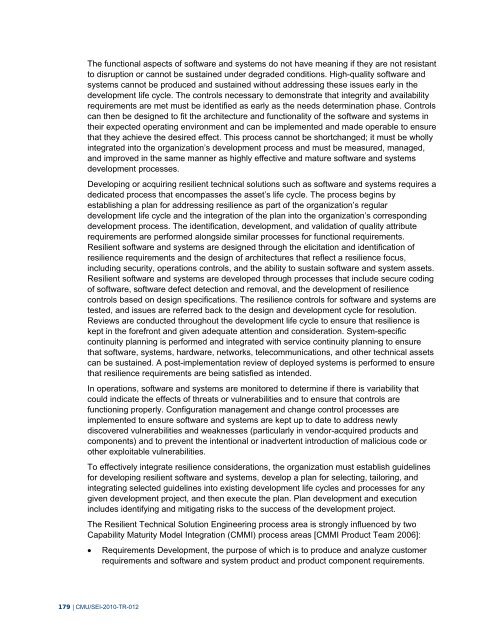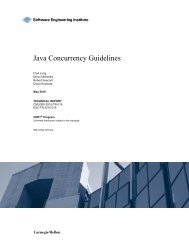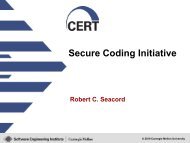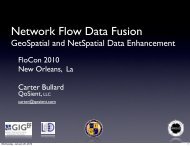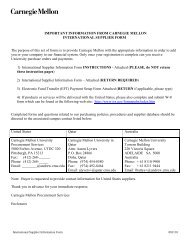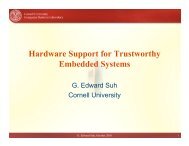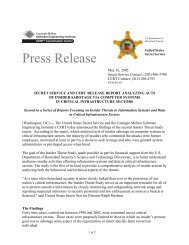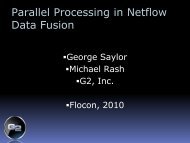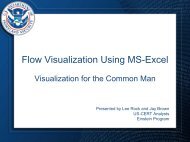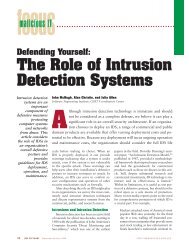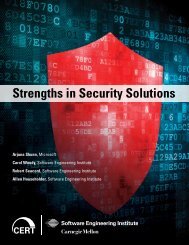CERT Resilience Management Model, Version 1.0
CERT Resilience Management Model, Version 1.0
CERT Resilience Management Model, Version 1.0
- No tags were found...
You also want an ePaper? Increase the reach of your titles
YUMPU automatically turns print PDFs into web optimized ePapers that Google loves.
The functional aspects of software and systems do not have meaning if they are not resistantto disruption or cannot be sustained under degraded conditions. High-quality software andsystems cannot be produced and sustained without addressing these issues early in thedevelopment life cycle. The controls necessary to demonstrate that integrity and availabilityrequirements are met must be identified as early as the needs determination phase. Controlscan then be designed to fit the architecture and functionality of the software and systems intheir expected operating environment and can be implemented and made operable to ensurethat they achieve the desired effect. This process cannot be shortchanged; it must be whollyintegrated into the organization’s development process and must be measured, managed,and improved in the same manner as highly effective and mature software and systemsdevelopment processes.Developing or acquiring resilient technical solutions such as software and systems requires adedicated process that encompasses the asset’s life cycle. The process begins byestablishing a plan for addressing resilience as part of the organization’s regulardevelopment life cycle and the integration of the plan into the organization’s correspondingdevelopment process. The identification, development, and validation of quality attributerequirements are performed alongside similar processes for functional requirements.Resilient software and systems are designed through the elicitation and identification ofresilience requirements and the design of architectures that reflect a resilience focus,including security, operations controls, and the ability to sustain software and system assets.Resilient software and systems are developed through processes that include secure codingof software, software defect detection and removal, and the development of resiliencecontrols based on design specifications. The resilience controls for software and systems aretested, and issues are referred back to the design and development cycle for resolution.Reviews are conducted throughout the development life cycle to ensure that resilience iskept in the forefront and given adequate attention and consideration. System-specificcontinuity planning is performed and integrated with service continuity planning to ensurethat software, systems, hardware, networks, telecommunications, and other technical assetscan be sustained. A post-implementation review of deployed systems is performed to ensurethat resilience requirements are being satisfied as intended.In operations, software and systems are monitored to determine if there is variability thatcould indicate the effects of threats or vulnerabilities and to ensure that controls arefunctioning properly. Configuration management and change control processes areimplemented to ensure software and systems are kept up to date to address newlydiscovered vulnerabilities and weaknesses (particularly in vendor-acquired products andcomponents) and to prevent the intentional or inadvertent introduction of malicious code orother exploitable vulnerabilities.To effectively integrate resilience considerations, the organization must establish guidelinesfor developing resilient software and systems, develop a plan for selecting, tailoring, andintegrating selected guidelines into existing development life cycles and processes for anygiven development project, and then execute the plan. Plan development and executionincludes identifying and mitigating risks to the success of the development project.The Resilient Technical Solution Engineering process area is strongly influenced by twoCapability Maturity <strong>Model</strong> Integration (CMMI) process areas [CMMI Product Team 2006]:Requirements Development, the purpose of which is to produce and analyze customerrequirements and software and system product and product component requirements.179 | CMU/SEI-2010-TR-012


